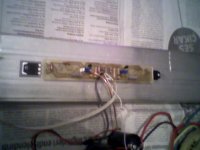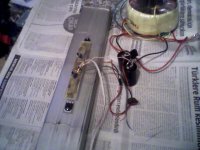Post up a pic .......
it is here
Attachments
I connected it to my Emu1212m soundcard but my packard bell laptop has headphone out and gives higher volume than emu card.I can not get much power with emu as much as i get with my laptop
you don't need an oscilloscope.
A DMM that reads both 200.0mVac and 2000mVac is perfect.
You need the same signal from each source. The PC can generate a standard 500Hz signal that you can use.
A DMM that reads both 200.0mVac and 2000mVac is perfect.
You need the same signal from each source. The PC can generate a standard 500Hz signal that you can use.
what is DMM?
DMM is short (acronym) for Digital Multi-Meter.A DMM that reads both 200.0mVac and 2000mVac
oh sorry i know DMM 🙂 but my DMM is broken too it can not measure AC .It only measures DC 🙂 But cheap multimeters can not measure 500 hz can it ? I think it can measure only 50 Hz .
you will be comparing one 500Hz voltage measurement to another similar voltage 500Hz signal.
When you are comparing like this a small error in frequency response does not affect the comparison. It only affects the absolute accuracy of the voltage measurements. Since all our amateur measuring systems have an accuracy tolerance, we should always remember that we cannot make good absolute measurements, but if we are careful we can make very good comparison measurements.
When you are comparing like this a small error in frequency response does not affect the comparison. It only affects the absolute accuracy of the voltage measurements. Since all our amateur measuring systems have an accuracy tolerance, we should always remember that we cannot make good absolute measurements, but if we are careful we can make very good comparison measurements.
we were measuring the amplifiers output with DMM when we were a child 😀 and were comparing their power 🙂 Can a cheap chinese multimeter (not RMS one.about 20$) measure 1khz signal with +- %3 ?
no. Unless the specifcation says it can and that the equiment is regularly re-calibrated to ensure it stays in specification.Can a cheap ..... multimeter (not RMS one) measure 1khz signal with +- %3 ?
Read what I said about comparison and absolute and why they are different.
umut1001, You didn't show the other side of your "heatsink" so it is difficult to have a good idea what it is or can do... but I would think it is too small...
You might get away with using two of those per channel, one per mosfet...
I would think that your aluminum is getting very very hot right now, IF you have biased the outputs into class A (that 1.3amps) - if you have less bias on them, then it will not get as hot, but will not be in Class A.
It is OK to run with lower bias, but you might have somewhat different sound quality...
_-_-bear
PS. keep in mind this amp has only 15dB of gain, so it will require more voltage at the input than usual to equal the gain of the "standard" power amp...
PPS. has anyone measured how much power or what % of full output the F5 produces with a standard 1vrms sine wave @ 1kHz input??
You might get away with using two of those per channel, one per mosfet...
I would think that your aluminum is getting very very hot right now, IF you have biased the outputs into class A (that 1.3amps) - if you have less bias on them, then it will not get as hot, but will not be in Class A.
It is OK to run with lower bias, but you might have somewhat different sound quality...
_-_-bear
PS. keep in mind this amp has only 15dB of gain, so it will require more voltage at the input than usual to equal the gain of the "standard" power amp...
PPS. has anyone measured how much power or what % of full output the F5 produces with a standard 1vrms sine wave @ 1kHz input??
Hi Bear.It is 50cmx10cmx5cm.I biased it for 1amp. the room's temperature is about 5celcius and i can touch my hand for 5secons as nelson says 🙂 but it will be hotter in summer because it reachs 39celcius here in my city Istanbul.I think i will use bigger ones.
I am curious that has anyone measured how much power or what % of full output the F5 produces with a standard 1vrms sine wave @ 1kHz input.
I am curious that has anyone measured how much power or what % of full output the F5 produces with a standard 1vrms sine wave @ 1kHz input.
Attachments
Hi Bear.It is 50cmx10cmx5cm.I biased it for 1amp. the room's temperature is about 5celcius and i can touch my hand for 5secons as nelson says 🙂 but it will be hotter in summer because it reachs 39celcius here in my city Istanbul.I think i will use bigger ones.
I am curious that has anyone measured how much power or what % of full output the F5 produces with a standard 1vrms sine wave @ 1kHz input.
you'll have much more thermal dissipation capacity from that heatsink , if you cut it in 4 pieces , place them with fins vertically and screw them together with nice Al or copper heat spreader
say - Al bar , 30x6mm is good enough
It is 50cmx10cmx5cm.
The equivalents of your heatsink are Fischer SK88 and Seifert KL209.
They're only practical to a length of 200mm, more economic is 150mm.
Additional dissipation of a 500mm length amounts to a few percent compared to a length of 200mm, at identical operating temperature.
Cut in four 125mm sections handles at least 2.5 times more heat, enough for a stereo F5.
Last edited:
the room's temperature is about 5celcius
Then you really need a nice Class A amplifier, don't you?
😎
Then you really need a nice Class A amplifier, don't you?
😎
I must built a krell ksa100 amp to warm the room because F5 does not have much gain and also heat 😀
On manual it is written that it has 15.15db gain.so when there is 1.3volts p-p in the input it outputs 40v p-p but it does not ?
Last edited:
F5 has enough gain for my application. I built one a few weeks ago. I replaced my tube push pull amp with the F5 for the Karaoke party. Every one loved the sound. Every one sang like a pro.
Very happy with it.
Very happy with it.
Last edited:
- Home
- Amplifiers
- Pass Labs
- F5 power amplifier


